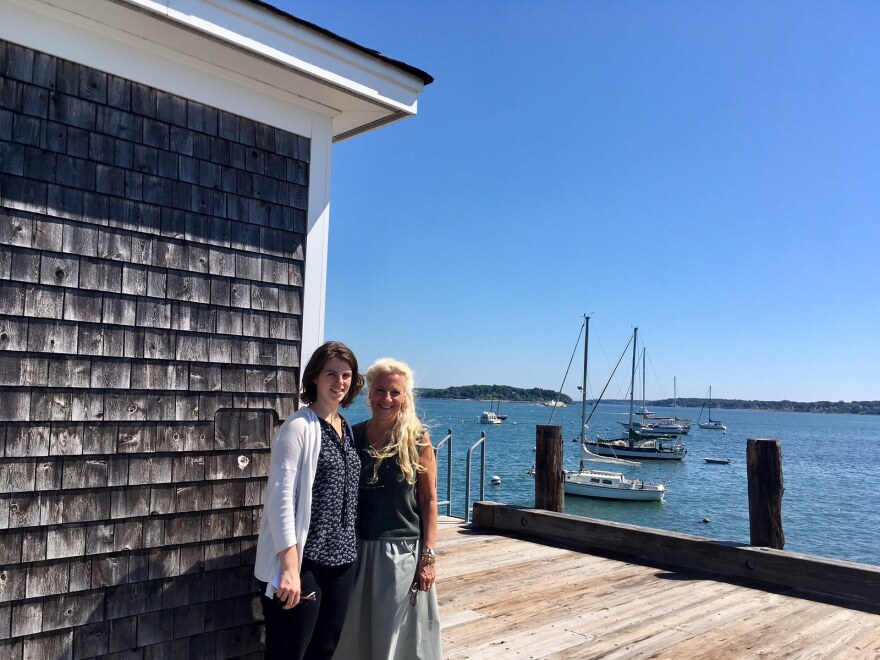Climate change, pollution and water acidity are all among the issues affecting the water in Maine. The vastness and complexity of ocean environments, however, make it difficult for scientists to measure these important changes in the water. That’s why one nonprofit is looking to its volunteers to put a modern spin on an old way of assessing water quality.
As you take a walk along the shores of Casco Bay this summer, you may notice other beachgoers taking pictures — of the water.
“Even though it looks beautiful out here, what goes on beneath the surface of the water is very different,” says Cathy Ramsdell.
Ramsdell is the executive director of the nonprofit Friends of Casco Bay, which is recruiting volunteers to capture photographs of the water in order to gauge its color. But there’s more to the project, called Color by Numbers, than just data collection.
“We wanted to find really low-threshold ways for people to get involved and get their hands wet,” says Ramsdell. “A lot of people can relate to the idea that if you look at nice blue-green water, it’s good, healthy water, and you want to jump in it and swim in it. And when you see water that’s yellowish-brown, we associate that with pollution in some form or water that’s not as healthy as it could be.”
Near the shore of Southern Maine Community College in South Portland at high tide, volunteer River Dufour demonstrates the process, which requires only a smartphone app.

“The app just takes a picture of the water, and you can flip through a color palette and try to match the color to the picture you took,” says Dufour, holding his phone parallel to the water. “I just have to take the picture and send the info over to Friends of Casco Bay, and they can do with that what they want.”
Friends of Casco Bay will measure the color of the water using the Forel-Ule color scale, and then enter the data into a catalog of water color that will be shared with scientists all over the world.
“The color measurement is a good proxy for things like water clarity and turbidity, and also it gives us a sense of other materials in the water that might produce color, things like minerals or organic material you can’t see," says Community Engagement Coordinator, Sarah Lyman.
Lyman says that Friends of Casco Bay has been collecting water quality data for nearly 30 years. But this project, the nonprofit’s largest volunteer recruitment effort ever, will generate loads of information from all around the bay that they wouldn’t be able to obtain otherwise.
“The value of this project is the fact that we can get a lot more measurements by having the community involved, by having a lot of volunteers all across the bay actively taking these measurements,” says Lyman. “Because with a full-time staff of eight, there’s a limited number of those measurements that we can take on our own, and so it’s really important to have a variety of people and a variety of locations getting those measurements.”

And, according to Dufour, the whole process is user-friendly. “The first time I went out it took me about 20 minutes and then it was done,” he says.
As the color data is being compiled, it may offer more detailed information about what’s happening in Casco Bay and why. What is known, says Ramsdell, is that the ecosystem is changing.
“Certainly temperature is rising and acidity seems to be increasing, which means PH is getting lower,” says Ramsdell. “Messing with the fundamental chemistry of the water absolutely will change what’s happening with the food webs out there.”
Ramsdell says that the bay has seen an increase in the number of harmful algae blooms, as well as invasive green crabs and milky ribbon worms, both of which are putting Maine’s wild clam population at risk. They attribute these and other changes in the water to a number of factors, including pesticide runoff and climate change.
“We know from the things we’re measuring under the surface of the water, there are absolutely a lot of changes afoot, and we know it’s a very complex system out there,” says Ramsdell. “It’s hard to know what’s changing what, what’s influencing what, and what’s happening with different critters, but anyone who is spending time recreating or working on the water will tell you that change is the operative word out there.”
Ramsdell says she hopes that involving the community with volunteer projects like this will motivate them to keep the bay healthy.

“Casco belongs to everybody... it’s the community’s resource, and we need to work together to take care of it,” she says.
Ramsdell also says that keeping the bay healthy doesn't have to mean volunteering.
"Just having measured conversations with our neighbors and members of our communities about what we do in our yards and in our parking lots and on our roofs, and talking about what we do at home, doesn’t necessarily stay at home," she says. "We’re not pointing fingers at people, we’re trying to work with the community while making the science accessible."




